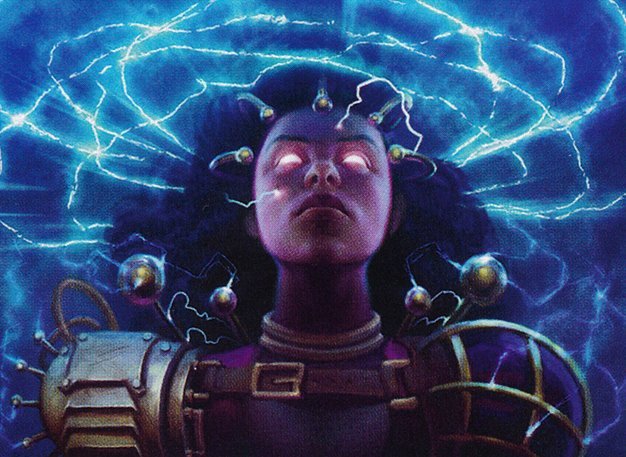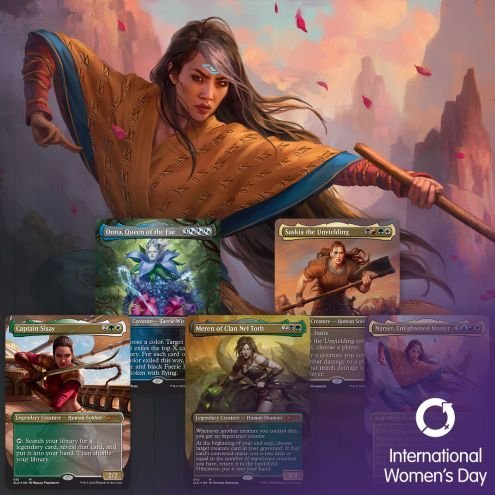I want to start this article by explaining the definition of cantrip: This term originated in Dungeons & Dragons and in the game the cantrips are magic that can be cast at no cost. In Magic: The Gathering the simplistic definition that we will find in online encyclopedias is: "a spell that draws a card in addition to its other effects".
We can find cantrips of any color or cost in Magic and this is at least curious, since many players associate the term only with blue spells, which manipulate the top of the deck and draw cards.
Ad

But it is not by chance that this association happens, cards like Ponder, Brainstorm e Preordain have a great differential: they make a very efficient card selection.
We all know that Magic is a strategy game, but it also includes a bit of luck, and what makes card selection so important is the ability it has to reduce the impact of that factor. That's exactly why Wizards has been more careful with the power level of this type of feature in the game.
One of the characteristics of our format is that card advantage based strategies end up standing out. It is no accident that Tron is the most relevant control of the format today. As a Big Mana, Tron can afford to bet on heavier cards like Mystical Teachings to make an accurate card selection, but I like to give the example of Snow Jeskai to explain the importance of cantrips, since Jeskai was a Boros with a blue splash, and whoever played this match will remember the importance of Preordain.
Certainly Pauper's powerful cantrips would do a lot of damage in other formats, but they work well in a format that doesn't have major threats capable of winning games on its own. Perhaps in a future where the power level of spells and creatures grows significantly, these cantrips can become a problem, but for now I prefer to consider it a privilege for Pauper players to have these cards at their disposal.

It is natural for players to feel lost in some decision making involving cantrips, especially when they have little experience with the deck they are playing. As much as there are some conventions, the truth is that this is a very subjective topic, for example, I have already read the following statement in forums:
If you have a Ponder and a Preordain in hand, play Ponder first, draw what you think is useful, and then cast the Preordain to put what is useless at the bottom of the library.
This statement may even be true for a large number of situations, but be careful when taking this as a rule, as there will certainly be times when this will not be the most correct move. Anyway, I think it is worth mentioning some heuristics already published on the internet.
According to Wikipedia, heuristics are cognitive processes used in non-rational decisions, being defined as strategies that ignore part of the information in order to make the choice easier and faster.
Brainstorm
The ideal is to have a way to shuffle or put on the bottom of your library (or to the grave) the useless cards that you returned with Brainstorm. Cards that can do this: Fetch Lands, Preordain, Thought Scour, Augur of Bolas.
Do not hold hands with a land if your only cantrip is a Brainstorm. You will run the risk of being cornered from the Brainstorm and stay several turns without drawing a land.
Keep in mind that the Brainstorm can be useful to transform a Delver of Secrets or enhance a Augur of Bolas. It is also worth remembering that it allows you to hide cards from your hand in response to a Duress for example. So take this into account when casting a Brainstorm just because you have mana available.
Ad
Ponder
Generally, you will want to play a Ponder before a Preordain, but in critical situations, when you need an immediate card, casting a Preordain before the Ponder allows you to potentially dig up to seven cards from your deck. And why not cast the Ponder first, since we would also dig the same amount of cards? It seems obvious, but in the heat of the moment we may not take into account that when we play Ponder and shuffle the deck, it is possible that the same cards remain on the top of the deck.
But as I said, there is no cake recipe, everything is very situational. Suppose you put your single Swirling Sandstorm to the bottom of your library at the beginning of the game because you needed to find your second land. Knowing that the card you need is at the bottom, the option will first be to shuffle the deck with Ponder, counting on Preordain and a little bit of luck.
Sideboard
It is not common to side-out cantrips, even if you have many options to include, it is recommended that you leave out something that you consider "just okay" against your oponente deck to maintain a cantrip that can help you find an answer that is better than "just okay".
An interesting approach to understand Pauper's cantrips is to know more about the function they have in each archetype.
Cantrip x Archetype
Tempo: A Tempo deck's game plan is to play one or two threats on the field and be able to protect those threats while disrupting the opponent's game plan. In this archetype the role of the cantrips is to find these threats, the means to protect them and the means to disrupt the opponent's game.
Mono U and UB Delver have these characteristics and make excessive use of cantrips, but while Mono U uses Ponder and Preordain, UB opts for Brainstorm because of Evolving Wilds and Ash Barrens.
I confess that I'm not a fan of Brainstorm on Mono U. There are those who consider it a mistake to play with the card on the deck, and there are those who prefer to have one more option to guarantee the transform of the Delver of Secrets. If one day I were to use this tech, it would certainly be on a list with four Augur of Bolas to enhance the card in the deck.
Mid Range / Control: Usually these are decks that take the game to the late game, the function of cantrips in this archetype is to offer more quality in the draws, we usually don't want to flood, but we also need to keep our land drop working. Preordain ends up being unanimous on the lists.
Combo: It is usually in these decks that most of the cantrips are concentrated. In Tribe, for example, in addition to the set (Ponder, Preordain and Brainstorm) we also have cards like Shadow Rift, Inside Out and even the Augur of Bolas itself.
The main function of cantrips in this archetype is to find the parts of the combo and the ways to execute it safely. I think it's worth mentioning that Tribe's more combocentric lists end up giving up playing with four copies of Preordain, precisely because this cantrip digs fewer cards in the deck.
Ad
Currently the combos are low in format and although the Tribe is gaining more and more characteristics of a Mid Range deck, the cantrips end up performing additional functions such as buffing the Seeker of the Way.
To end the article, we will count on the participation of Jonathan Jansen who played with the Tribe deck for a long time and cordially agreed to write a short text to share his vision of Pauper's cantrips - Thank you!
"A cantrip is a facilitator for your game plan. It is a tool for you to manage your resources by assessing how your game is doing, and where you want to take it.
Playing a cantrip involves much more ways than just looking for a card or manipulating the top of the deck. And now you may be thinking "What the hell does he mean by that?"
Evaluate your hand and see how your game develops with the resources you have. Imagine your next draw: and question what you're looking for. This is essential so that when playing a cantrip, you get the most value out of it. For a long time I played combo with Pauper, it made me think a lot about the possibilities of drawing, the chances of keeping the card on top or trying to shuffle. This experience made me more clear about how and when to use my resources, we often need to be calm and wait for a more opportune moment.
Cantrip is a privilege! And understanding this is the first step in designing the best strategies within your game.
The big message is that in the end, cantrip is a science, and each player can raise their thesis and prove their own theory. At Magic, we are all scientists."
I hope you enjoyed reading and that the article was useful in some way. Remember that the best way to understand Pauper's cantrips is to play a lot! So, let's practice ; D
Feel free to use the comments section for any questions, criticisms or suggestions.
See you next time.







— Comments0
Be the first to comment